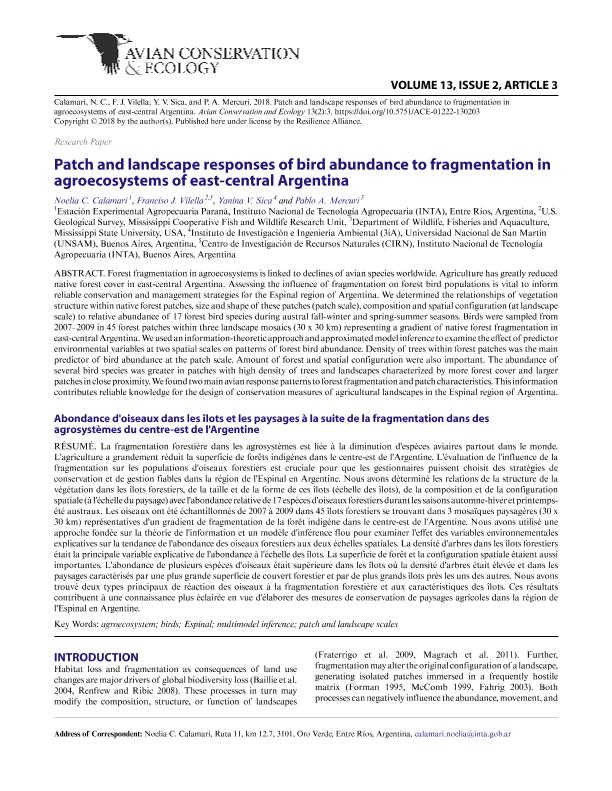Mostrar el registro sencillo del ítem
dc.contributor.author
Calamari, Noelia Cecilia

dc.contributor.author
Vilella, Francisco J.
dc.contributor.author
Sica, Yanina Vanesa

dc.contributor.author
Mercuri, Pablo Alberto

dc.date.available
2020-04-16T17:21:24Z
dc.date.issued
2018-12
dc.identifier.citation
Calamari, Noelia Cecilia; Vilella, Francisco J.; Sica, Yanina Vanesa; Mercuri, Pablo Alberto; Patch and landscape responses of bird abundance to fragmentation in agroecosystems of east-central Argentina; The Resilience Alliance on behalf of the Society of Canadian Ornithologists and Bird Studies Canada; Avian Conservation and Ecology; 13; 2; 12-2018; 1-28
dc.identifier.issn
1712-6568
dc.identifier.uri
http://hdl.handle.net/11336/102759
dc.description.abstract
Forest fragmentation in agroecosystems is linked to declines of avian species worldwide. Agriculture has greatly reduced native forest cover in east-central Argentina. Assessing the influence of fragmentation on forest bird populations is vital to inform reliable conservation and management strategies for the Espinal region of Argentina. We determined the relationships of vegetation structure within native forest patches, size and shape of these patches (patch scale), composition and spatial configuration (at landscape scale) to relative abundance of 17 forest bird species during austral fall-winter and spring-summer seasons. Birds were sampled from 2007–2009 in 45 forest patches within three landscape mosaics (30 x 30 km) representing a gradient of native forest fragmentation in east-central Argentina. We used an information-theoretic approach and approximated model inference to examine the effect of predictor environmental variables at two spatial scales on patterns of forest bird abundance. Density of trees within forest patches was the main predictor of bird abundance at the patch scale. Amount of forest and spatial configuration were also important. The abundance of several bird species was greater in patches with high density of trees and landscapes characterized by more forest cover and larger patches in close proximity. We found two main avian response patterns to forest fragmentation and patch characteristics. This information contributes reliable knowledge for the design of conservation measures of agricultural landscapes in the Espinal region of Argentina.
dc.description.abstract
La fragmentation forestière dans les agrosystèmes est liée à la diminution d'espèces aviaires partout dans le monde. L'agriculture a grandement réduit la superficie de forêts indigènes dans le centre-est de l'Argentine. L'évaluation de l'influence de la fragmentation sur les populations d'oiseaux forestiers est cruciale pour que les gestionnaires puissent choisit des stratégies de conservation et de gestion fiables dans la région de l'Espinal en Argentine. Nous avons déterminé les relations de la structure de la végétation dans les îlots forestiers, de la taille et de la forme de ces îlots (échelle des îlots), de la composition et de la configuration spatiale (à l'échelle du paysage) avec l'abondance relative de 17 espèces d'oiseaux forestiers durant les saisons automne-hiver et printemps-été austraux. Les oiseaux ont été échantillonnés de 2007 à 2009 dans 45 îlots forestiers se trouvant dans 3 mosaïques paysagères (30 x 30 km) représentatives d'un gradient de fragmentation de la forêt indigène dans le centre-est de l'Argentine. Nous avons utilisé une approche fondée sur la théorie de l'information et un modèle d'inférence flou pour examiner l'effet des variables environnementales explicatives sur la tendance de l'abondance des oiseaux forestiers aux deux échelles spatiales. La densité d'arbres dans les îlots forestiers était la principale variable explicative de l'abondance à l'échelle des îlots. La superficie de forêt et la configuration spatiale étaient aussi importantes. L'abondance de plusieurs espèces d'oiseaux était supérieure dans les îlots où la densité d'arbres était élevée et dans les paysages caractérisés par une plus grande superficie de couvert forestier et par de plus grands îlots près les uns des autres. Nous avons trouvé deux types principaux de réaction des oiseaux à la fragmentation forestière et aux caractéristiques des îlots. Ces résultats contribuent à une connaissance plus éclairée en vue d'élaborer des mesures de conservation de paysages agricoles dans la région de l'Espinal en Argentine.
dc.format
application/pdf
dc.language.iso
eng
dc.publisher
The Resilience Alliance on behalf of the Society of Canadian Ornithologists and Bird Studies Canada
dc.rights
info:eu-repo/semantics/openAccess
dc.rights.uri
https://creativecommons.org/licenses/by-nc/2.5/ar/
dc.subject
AGROECOSYSTEMS
dc.subject
BIRDS
dc.subject
ESPINAL
dc.subject
MULTI-MODEL INFERENCE
dc.subject
PATCH AND LANDSCAPE SCALE
dc.subject.classification
Ciencias Medioambientales

dc.subject.classification
Ciencias de la Tierra y relacionadas con el Medio Ambiente

dc.subject.classification
CIENCIAS NATURALES Y EXACTAS

dc.title
Patch and landscape responses of bird abundance to fragmentation in agroecosystems of east-central Argentina
dc.title
Abondance d'oiseaux dans les îlots et les paysages à la suite de la fragmentation dans des agrosystèmes du centre-est de l'Argentine
dc.type
info:eu-repo/semantics/article
dc.type
info:ar-repo/semantics/artículo
dc.type
info:eu-repo/semantics/publishedVersion
dc.date.updated
2020-04-15T20:42:27Z
dc.journal.volume
13
dc.journal.number
2
dc.journal.pagination
1-28
dc.journal.pais
Canadá

dc.journal.ciudad
Wolfville
dc.description.fil
Fil: Calamari, Noelia Cecilia. Instituto Nacional de Tecnología Agropecuaria. Centro Regional Entre Ríos. Estación Experimental Agropecuaria Paraná; Argentina
dc.description.fil
Fil: Vilella, Francisco J.. Mississippi State University; Estados Unidos. Mississippi Cooperative Fish and Wildlife Research Unit; Estados Unidos. United States Geological Survey; Estados Unidos
dc.description.fil
Fil: Sica, Yanina Vanesa. Consejo Nacional de Investigaciones Científicas y Técnicas; Argentina. Universidad Nacional de San Martín. Instituto de Investigación e Ingeniería Ambiental. Laboratorio de Biodiversidad, Limnología y Conservación; Argentina
dc.description.fil
Fil: Mercuri, Pablo Alberto. Instituto Nacional de Tecnología Agropecuaria. Centro de Investigación de Recursos Naturales; Argentina
dc.journal.title
Avian Conservation and Ecology
dc.relation.alternativeid
info:eu-repo/semantics/altIdentifier/url/http://www.ace-eco.org/vol13/iss2/art3/
dc.relation.alternativeid
info:eu-repo/semantics/altIdentifier/doi/http://dx.doi.org/10.5751/ACE-01222-130203
Archivos asociados
